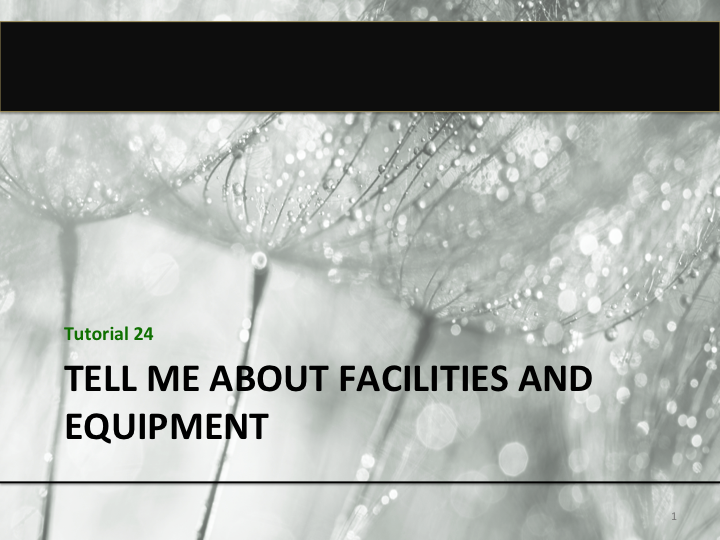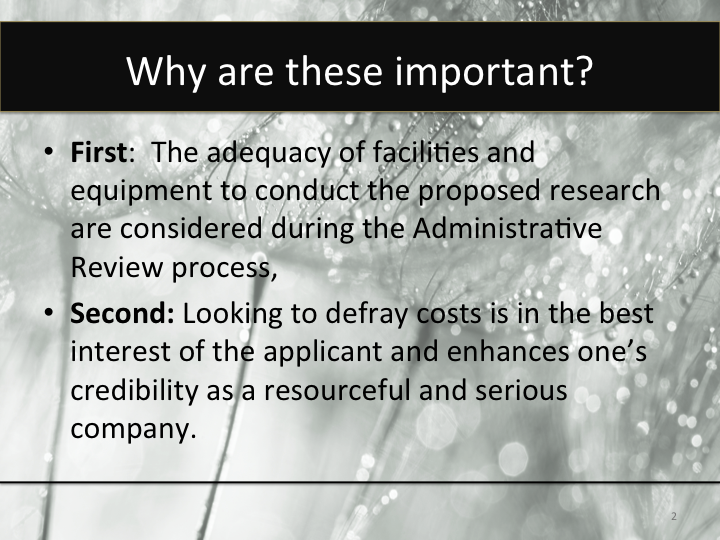Tutorial 24:
Facilities and Equipment
Phase I SBIR/STTR applicants seldom devote much attention to the equipment and facilities that will be used in their proposed project. This is unfortunate, because these resources are important in two respects.
First, they are considered in the Phase I proposal review and evaluation process which starts with the administrative and technical screening. If the proposal does not include the required content regarding equipment and facilities, or does not include enough explanation of what equipment/facilities are needed or where the applicant will get them, then the proposal may never pass this go/no go threshold. Showing that the applicant understands what is needed, and has secured access to the needed equipment and facilities, adds credibility to the proposal. It also is used by technical reviewers “to assess the capability of the organizational resources available to perform the effort proposed.”
The merit review criteria used by DOE evaluators of Phase I SBIR/STTR proposals includes the proposer’s “ability to carry out the project,” and “level of adequacy of equipment and facilities” for the proposed R&D—therefore, if the equipment and facilities appear inadequate, or aren’t fully described and justified, the applicant could lose valuable points in the review process.
Second, paying attention to the facilities and equipment is in the self interest of the Phase I SBIR/STTR applicant. Research equipment is often expensive, and can be beyond the resources of many small firms. But SBIR/STTR makes funding available to these small firms via the grant to purchase equipment (with the limitations discussed herein), or accessing sophisticated equipment or facilities at universities and Federal laboratories. To the latter point, seeking SBIR/STTR funding can give a small firm the credibility to access sophisticated equipment & facilities, through either subcontracting arrangements, open market leases, or user facility agreements, with the “credibility” coming from the small firm being successful in the highly competitive and technically rigorous SBIR/STTR programs.
So now that the importance of equipment and facilities to an SBIR/STTR Phase I applicant is clear, let’s discuss each of these resources.
An important first question is, what is considered “equipment”? DOE defines equipment as “an article of tangible, nonexpendable, personal property, including exempt property, charged directly to the grant, having a useful life of more than one year and an acquisition cost of $5,000 per unit or more.” We’ve highlighted several key words and phrases. First, there are both life and cost components to determining if something is equipment. Second, the item has to meet both time and cost thresholds; i.e., something that lasts more than 1 year but costs less than $5000 is not considered equipment. Third, the word “directly” is extremely important in this definition, because it differentiates equipment that is purchased as part of the direct Phase I R&D budget versus that purchased by other means.
If you purchase a piece of equipment for your project, you could either specify it in the Phase I SBIR/STTR budget as a direct cost, or you could roll it into your indirect cost rate (as part of your depreciation expense), or you could pay for it out of the fee or profit you charge on the project. Many requirements and restrictions that DOE imposes on equipment in your SBIR/STTR proposal only apply to equipment you plan to buy as a direct cost.
Here are some of those requirements and restrictions on equipment acquired as direct costs to the Phase I DOE project:
- If you buy equipment as a direct cost, then the Federal government will retain ownership of it. It may be possible to eventually transfer ownership to your company, but not initially.
- If you are borrowing equipment from some third party at no cost, you must provide verification of this in your proposal. More on this requirement later in this discussion.
- Any equipment acquired as a direct cost must be fully explained and justified in the proposal text, budget and budget justification sections. Again, we’ll have more to say about this later.
- Agencies do not approve purchase of common or routine equipment as a direct cost in your SBIR/STTR proposal. If you really want a laptop for example, then DOE is not going to pay for it as a direct cost—unless you need a specialized tablet specifically for the proposed Phase I R&D work, and it would not be reasonable to expect you to already own such a computer as part of your other contracts and business activities.
Again, these are rules and restrictions that apply to equipment that is purchased as direct costs in your Phase I DOE SBIR/STTR budget, and not to equipment acquired through your indirect rate or your fee/profit. Therefore, if you do not want to be limited by these requirements, you should plan to purchase equipment with indirect or fee/profit dollars or funds not associated with the grant proposal, e.g., small business capital.
Facilities
DOE imposes several expectations and limits on the facilities where you will conduct the Phase I SBIR/STTR research.
First, DOE states that “…one of the performance sites indicated must be that of the applicant small business…” Therefore, at least part of the Phase I project “research and analytical work” performed by the your firm needs to be done in your facilities, even if it is only the analysis, number-crunching, and/or report writing being done in your home-based office.
Second, “[w]hen required…, access to special facilities…in another organization is permitted, as in cases where the SBIR/STTR awardee has entered into a sub-contractual agreement with another institution for a specific, limited portion of the research project.” This qualifier makes it possible for you to conduct some of your Phase I project in facilities that you do not own. This opens the door to have on your project, for example, a faculty member working within their university laboratory, or a sophisticated user facility at one of the Federal Laboratories.
We believe there are actually seven (7) different places in the Phase I proposal where equipment and facilities should be addressed:
- Work Plan section of the Project Narrative. As part of explaining “how” you are going to do the Phase I research, you should mention the equipment being used. By also stating “where” each task or activity will be performed, you can indicate when a particular facility is being used.
- Facilities/Equipment section of the Project Narrative. DOE requires this section in your narrative (do not put it in attachments to Fields 10 and 11 of the SF424 application form). “Items of equipment to be leased or purchased must be described and justified in this section” is the guidance from DOE; this suggests that this section should not be brief, vague or general. Imagine someone is asking you to buy them a $5,000 item—what would you want them to say before you agree to do so? DOE suggests this discussion might include capacities, pertinent capabilities, relative proximity to other resources being used in the project, and extent of availability of the equipment and facilities. DOE does not want to read generalized boilerplate text about irrelevant facilities and equipment of the applicant or its subcontracts, and therefore advises “describe only those resources that are directly applicable to the proposed work.”
- Project/performance site form. This should include the address of the site(s) where the work will be performed, remembering that at least one of them has to be the small business applicant’s location. DOE advises that you should NOT check the box regarding “I am submitting an application as an individual, and not on behalf of a company…” because only small businesses can receive SBIR/STTR awards.
- Section C of Research & Related Budget Form. List separately each piece of equipment (meeting the earlier definition) that you propose to buy as a direct cost on the Phase I SBIR/STTR project.
- Section F.6 of Research & Related Budget Form. Include here any other equipment and/or facilities that you will be leasing or renting as a direct cost on the project
- Section H of Research & Related Budget Form. Your indirect rate (or its component parts like overhead and G&A) should encompass general costs of being in business such as renting company facilities and paying for utilities. And, per the earlier discussion, this is where you would roll into your cost proposal a portion of the cost of equipment that you have or are acquiring as indirect costs and are included in your depreciation expense, including general and routine equipment.
- Budget Justification of Research & Related Budget Form. The DOE requires that anything you listed in Sections C and F.6 be justified here. Your explanation should be brief, and consistent with (but not duplicative of)what you wrote in the facilities/equipment section of the Project Narrative. According to DOE, “[a]ll proposed purchase of equipment will be carefully reviewed relative to need and appropriateness for the research or R&D proposed,” so don’t take this justification section lightly. You might indicate, as part of your justification of Section H, that your indirect rate includes equipment that has been acquired as general cost. This budget justification will be attached to Field K of the SF424 proposal application form.
A couple of closing words of advice:
- DOE does not include the cost of purchasing or leasing equipment when determining the percentage or Level-of-Effort requirement of an SBIR/STTR project being done by the applicant small business versus subcontractors and consultants.
- DOE asks “to the extent possible” that American made equipment be purchased or leased. Note that “made” does not necessarily mean the same as ownership of the manufacturer: for example, Toyota builds cars in America, while American computer giant Dell manufactures laptops in foreign countries.
- As discussed earlier, the fee/profit portion of a Phase I SBIR/STTR budget can be used to acquire equipment. However, any such plan should not be included in the budget justification for the fee/profit; instead, the justification should focus on the allowability of fee/profit of a reasonable amount on SBIR/STTR projects. That “reasonable” amount typically is considered to be 7% or less of the direct and indirect costs. That equates to about $10,000 in a $150,000 Phase I award.
Quiz: Tutorial 24: Facilities and Equipment
1
DOE does not allow equipment to be purchased as a direct cost in a Phase I SBIR/STTR project
Nice Work
Try Again
2
Which of the following statements is NOT accurate?
Nice Work
Try Again
3
How can equipment be purchased on an SBIR/STTR project?
Nice Work
Try Again
4
Written verification by a 3rd party source of facilities/equipment is only required if the facilities/equipment are being purchased, leased, or rented
Nice Work
Try Again
5
Restrictions and rules on purchase and justification of equipment applies to only those items being purchased as direct costs on a Phase I SBIR/STTR project
Nice Work
Try Again
6
Which of the following statements is accurate?
Nice Work
Try Again
7
Seeking an SBIR/STTR award that includes a budget for the use of sophisticated facilities or equipment can increase the credibility and seriousness of intent of a small business when it approaches a university or Federal Laboratory about using the institution’s sophisticated facilities or equipment
Nice Work
Try Again

